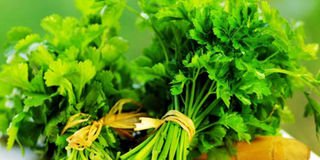Coriander can help farmers fight pests

Agronomists advise that you plant coriander earlier than the crops. Courtesy photo.
Peter Magomu, a farmer from Mbale District is cutting his production cost by more than half by growing coriander, a crop he has discovered has the ability to ‘seduce’ pest-eating insects and save him on pesticide costs.
How coriander attracts insects
Ladybird insect, which is easily attracted to the coriander, feeds on aphids, whiteflies, mites, among other soft-skinned pests that attack crops.
He has evaded chemical costs on his cabbages after including a few stems of coriander in his one-eighth acre farm, and the results, he says were “amazing”.
“I had grown tomatoes in the same farm on an earlier season. Aphids intruded and curled the soft parts of the tomatoes, draining all cell sap (plant juice),” Magomu says.
The pests
Aphids are some of the worst pests attacking pepper, tomatoes, cabbage, kales, beet-roots, broccoli, Brussels sprout, lettuce, eggplant, potatoes, among other crops.
Magomu used a few stems of the coriander and ensured that the ladybirds do not overfeed, therefore, fail to feed on the pests.
He used to spend about Shs5,000 daily in controlling the pests something that he has reduced to at most Shs1,000 per day.
Importance of ladybirds
Sunflower nectar is also another inducer of ladybirds into farms. According to One Kind, a Scotland animal protection organisation, a ladybird can eat about 5,000 aphids during its three to six weeks lifespan.
One ladybird lays hundreds of eggs on aphid colonies and other plant-eating pests.
And they start feeding immediately after hatching, the organisation says.
The insect’s larval stage in the most active stage, where they actively feed, therefore, disarming the pests.
The farmer says the heavy application of pesticides on his tomato farm killed insects, which may have included beneficial ones such as the ladybird.
With the European and other export, markets demanding minimal pesticide use in production, Integrated Management Practices, which depends on biological means to eliminate pests and diseases, remain the most viable option.
Magomu says the next time a farmer sees the ladybird, they should ‘hug and welcome’ them to the shamba (garden) because they are “great friends”.
For effective control, coriander has to be planted earlier than the main crop to ensure by the time transplanting is being done, the ‘soldiers’ are ready for the battle.
There are more than 10 biological pest control methods in farming.
Planting tips
Coriander enjoys a sunny position but appreciates a little shade during the hottest part of the day. Plants will run to seed more quickly if stressed by hot weather so this is important for leaf varieties.
Sowing coriander
Coriander is sown from late March until early September. To achieve a constant supply of leaves through the season sow small amounts every three weeks. The best months for leaf production are September, October and November. Coriander will grow best sown directly rather than grown in seed trays and transplanting.
This is because transplanting disturbance will also cause then to run to seed.
Sow directly into well drained, fertile soil. If your soil needs to be improved add good garden compost or well-rotted manure. Rake into the surface of the soil to remove any large lumps or stones leaving a fine and even tilth. Seeds are best sown in groups of five spaced 20cm between rows and 20cm between plants.
You can also grow coriander successfully in pots or trays filled with a good multipurpose compost. Coriander plants have deep tap roots so pots need to be at least 25cm deep.




